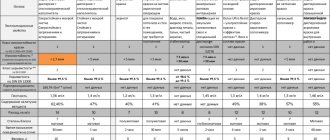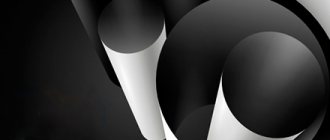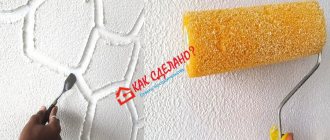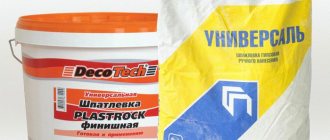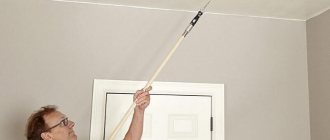Mathematical method of determination
How to calculate the amount of paint for walls so that the remainder is kept to a minimum? Many people try to save money on finishing during renovation work. This can be done using very simple calculations.
So, how to calculate paint consumption using mathematical formulas and definitions? We calculate the consumption based on the area of the room. To do this you need to follow these steps:
- Calculation of paint consumption begins with measuring the vertical bases. First you need to determine the height, and then measure the width of each wall. It is important to take into account all non-standard projections and recesses on the walls.
- The second step is to calculate the area of the bases. The width of each wall is multiplied by the height of the room. Afterwards, everything is added up to obtain the total area of the room. Example: the width of one wall is 4 m, the second is 3 m, the height is 2.5 m. Calculation: 2.5x4 = 10 m² and 2.5x3 = 7.5 m². We calculate the total area: (10x2) + (7.5x2) = 35 m².
- It is worth considering that this is the full value, but window and door openings will not have to be processed. The deduction of paint for painting from these voids is determined by the size of the openings. Therefore, you need to measure the height and width of windows and doors, calculate their area and subtract them from the total value of the room.
- If it is necessary to process additional elements, their area should also be determined. In this case, the amount of paint in the standard may not be enough.
- Each can indicates how much paint is needed per square meter. This does not apply to water-based paint, since this type of material has some features.
- You need to calculate the paint in accordance with the area of the room, that is, multiply the number of square meters by the amount of paint with the addition of 10-20%, which are taken into account for unforeseen expenses.
Calculations for painting walls are simple. It is enough to be able to determine surface areas. If such wall treatment is being done for the first time, then the product for such finishing may require a little more than indicated on the package.
On video: how to calculate the area of the walls in a room.
What difficulties may arise when using a spray gun?
The wall finishing must be of high quality, so you must be able to use the equipment correctly. For example, you should keep the spray gun at a distance of 150-200 mm from the wall, then the painting will be smooth and beautiful.
If tinting or decorative sprinkling is required, the distance can be increased.
To ensure an even coating, it is recommended to first practice on a piece of cardboard or wood. It is necessary to adjust the operation of the nozzle, achieve an even jet, apply a couple of test stripes in different directions. After this, you can start doing the work.
Read also: Polymer materials composition structure properties binders
When using a spray gun to paint walls, you may encounter some problems:
- Smudges appear along the edges. This happens because the air flow is too strong. To eliminate the error, the air flow must be reduced or a more viscous composition must be used for refueling.
- Abundant streaks appear on the wall under the middle of the stain. This is explained by excess paint flow. It is necessary to experimentally reduce the flow passing through the nozzle. Perhaps the air stream needs to be made a little stronger.
- After application, the paint stain appears dusty. This problem usually occurs because the viscosity of the paint is too high. This indicates that it is necessary to dilute it to a consistency that will be suitable for work. This can also be achieved experimentally.
Painting walls with a spray gun is simple and convenient. The surface is smooth and of high quality. Paint consumption is minimal, and little time is spent on work. To paint walls, you can use different types of spray guns, all of which are suitable for different compositions. It is important to pre-adjust the torch and air flow so that the stream is not only smooth, but also covers the surface correctly and there are no drips or traces of dust.
Determining the amount of paint for the ceiling
How to calculate the right amount of paint for the ceiling? Painting the ceiling requires a little more material than vertical planes. This feature lies in the location of the surface relative to the finish. You will need the following algorithm for determining the volume of paint for the ceiling:
- Calculate the surface value according to mathematical formulas. You need to first measure the length and width of the ceiling.
- The calculated volume is determined in accordance with the consumption instructions indicated on the packaging.
- It is better to multiply the required amount of paint by two, since in order for the surface to acquire the most aesthetically attractive appearance, it will require application in at least two layers.
Consumption of oil paint per 1m2 on metal.
Calculation of oil dye for metal, calculated in grams, is the most convenient indicator, since most often we know information about the surface area in advance. The area needs to be calculated, taking into account all the unevenness, the level of absorption, how many layers need to be applied.
Among the most significant factors determining material consumption, color should also be highlighted. The number of layers and quality of the coating will depend on this. Since color density depends on pigmentation, costs will vary depending on the tone.
Oil paint consumption rates.
The standard calculation of material when painting in one layer is 130-140 g per 1 m2. Light-colored paints have a lower density, which increases their consumption, meaning the surface will have to be painted in two or three layers.
The table shows the calculation of oil dye depending on color:
| Paint color | Coverage area with 1 kg |
| White | 6-10 m2 |
| Yellow Red | 5-10 m2 |
| Green | 10-14 m2 |
| Blue | 11-16 m2 |
| Brown | 12-17 m2 |
| Black | 17-20 m2 |
Online calculator to help
You can only check what you calculated yourself using a special calculator. The advantage of such a program is that with its help additional operating conditions are determined. It is possible to calculate the required volume of material that will be required in the case of different surfaces, be it plaster, concrete, wood or metal. In addition, online calculators available on the Internet allow you to determine the consumption of different types of paint (acrylic, water-based, silicone, latex, etc.).
To calculate, just enter data on the size of the room in the calculator, select the type of paint and type of surface.
>Go to calculator<
Consumption of PF-115 paint per 1 m2 for metal.
The abbreviation “PF” in the name of the enamel means PENTAFTHAL. It’s easy to decipher – the paint material contains alkyd resins and semi-dried oils, which allow the paint to dry quickly.
Enamel PF 115 occupies a leading position in the market of paints and varnishes. If we describe it in one word, then the most appropriate one would be “versatility.” Used for painting any type of surface. The paint can be mixed with other compounds, as well as with a primer.
Read also: Repair of axial piston pump
Consumption rates PF-115 per 1 m2.
As practice shows, the rate of material consumption varies from 100 to 180 g. Also, professionals say that on average a can weighing one kilogram is enough to paint 15 m2 of prepared surface. Also, the consumption of PF 115 directly depends on the selected color pigment.
Below is a table of the approximate consumption of PF-115 enamel (depending on the selected color):
| Color | How much area is 1 kg of paint enough for? | Paint consumption per 1m2, g |
| White | 7–10 m2 | 100–140 g |
| Yellow | 5–10 m2 | 100–180 g |
| Green | 11–14 m2 | 70–90 g |
| Blue | 12–17 m2 | 60–84 g |
| Brown | 13–16 m2 | 63–76 g |
| Black | 17–20 m2 | 50–60 g |
You can reduce the amount of coloring composition if you choose a silicone-based roller to apply it.
Practical tips for calculating paint
Before purchasing paints and varnishes, you should take into account the condition of the surface, the need for stripping, priming or additional sanding. You can turn to the specialists of the Odyssey online store , who will help you calculate the required volume of paint, tell you about practical ways to reduce costs, and offer high-quality domestic or European products.
Russian buyers have appreciated the benefits of inexpensive paints and enamels of their own brand ODISSEY, each batch of which undergoes official certification. Non-toxic and environmentally friendly raw materials are used in the production of paints, and delivery to the buyer’s door is organized. Cans and buckets are marked with detailed information about average consumption, so it will not be difficult to calculate how many liters of paint should be used for each room.
Types of façade paints and varnishes
A wide range of dyes are offered on the construction market, which is explained by the variety of building materials and climatic operating conditions. All facade paint and varnish compositions are divided into two groups according to the type of solvent:
- Water-dispersed (aqueous) . Water, in a special form (dispersion or suspension, solid particles in a liquid medium), contains polymer binders: latex, acrylic, vinyl acetate (PVA). The compositions are valuable because they are odorless, and simple water is enough to dilute the dye, wash the instrument or erase stains.
- On organic solvents . The basis is chemical solvents (for example, white spirit). Such paints allow you to get a brighter, denser shade, but take longer to dry, especially at low temperatures. The advantage is that they can be applied at high air humidity, and the pungent odor on the street practically does not cause any inconvenience.
Several types of dyes are used for facade work Source izi.ua
Based on the binder material, compositions for exterior finishing are divided into the following categories:
- Mineral . High-quality crushed natural minerals serve as coloring pigments. As a rule, mineral dyes are understood as lime dyes, the binder of which is slaked lime. There are compositions based on cement or chalk. The main advantages are low cost, preservation of vapor permeability, and resistance to low temperatures.
- Silicate . They are classified as mineral (contain chalk and talc), but they are often separated into a separate group due to the addition of liquid potassium glass. The composition is two-component, so it is mixed immediately before application. It is non-toxic, dissolves in water, and creates a vapor-permeable coating.
- Acrylic . The acrylic polymer emulsion is easy to use, as it can be applied without any special restrictions and is used in exterior and interior work.
Silicone-modified (latex) weather-resistant paint Source alkiv.ua
- Silicone . They combine the advantages of silicate and acrylic compounds. They are characterized by high elasticity, which makes the coating resistant to various external damage and shrinkage processes in the walls. They form a dense layer that is impervious to dirt and atmospheric moisture. The main disadvantage is the high price tag.
What determines the consumption of paints and varnishes and how to calculate it
Facade plaster consumption per m2 is always indicated by the manufacturer on the packaging. But this indicator is considered average and can only be taken into account when creating optimal working conditions, which is not always feasible in practice. Consumption may be affected by:
- The quality of the base, uneven and unprepared walls will require the application of a thicker layer of product to obtain a beautiful result;
- The presence of pores in the material also increases consumption;
- The number of layers of paint that will be applied to obtain the desired bright and even result;
- Tools that will be used to distribute the layer. The most expensive brush option, the most economical spray bottle.
If operating conditions are optimal, you can use an online calculator where you need to enter the surface area and average flow rate.
The most expensive brush option, the most economical spray bottle.
Powder paint consumption per 1m2 for metal.
Using this type of paint, you can achieve a finish that would not be possible to achieve using conventional liquid paints and varnishes. The films created by such paints can withstand any load.
You can find out how much powder dye is consumed per 1m2 if you take into account the thickness of the applied layer and the weight of the dye. The lighter it is, the less it will be needed.
The thickness of the applied layer must be at least 100 microns. Practice has proven that to reduce the consumption rate of this type of paint, it is necessary to use a sprayer. The same must be taken into account when determining the consumption of high pressure paint per 1m2. When using this tool, approximately 120-140 grams of coloring agent will be needed per m2.
